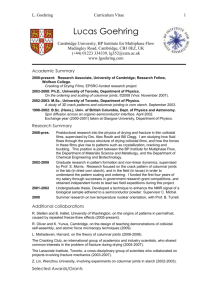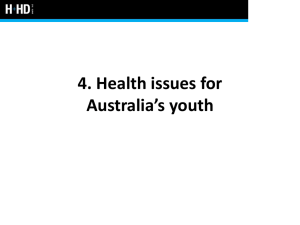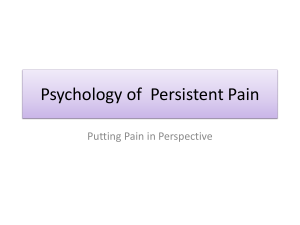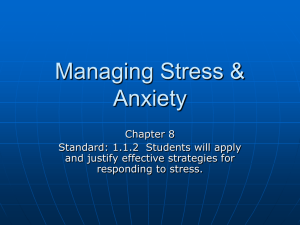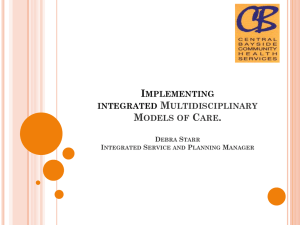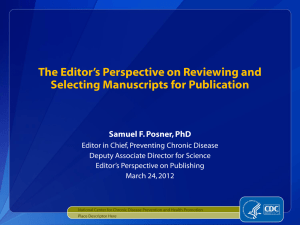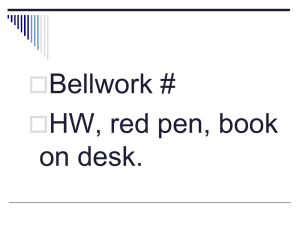ADSA Chronic Care Management
advertisement
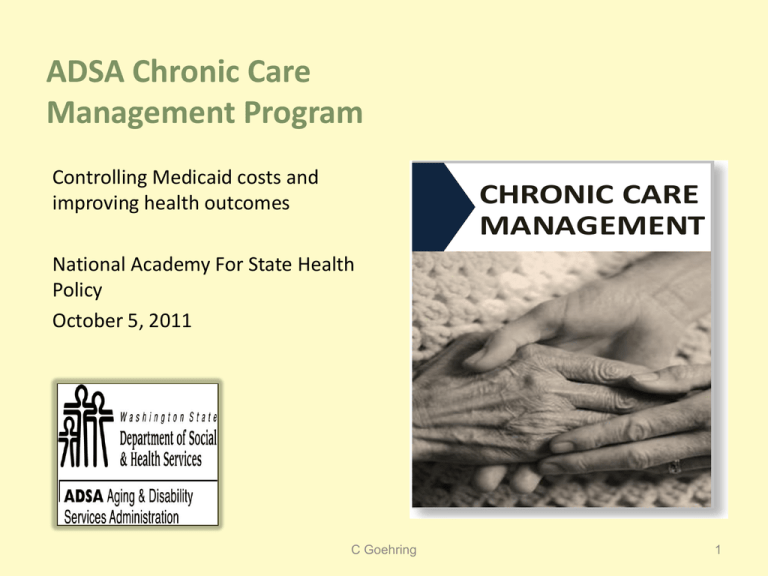
ADSA Chronic Care Management Program Controlling Medicaid costs and improving health outcomes CHRONIC CARE MANAGEMENT National Academy For State Health Policy October 5, 2011 C Goehring 1 A Look At The Scope of the Problem: Making the Case for Chronic Care Management • “What is right with you is a lot more powerful than what is wrong with you” • C Goehring 2 Washington State Medicaid Impact • Five percent of WA Medicaid clients account for 50 percent of the costs. • They are consumers of LTC • Are diagnosed with depression and chronic pain. • Current health care system is focused on acute care and misses working with clients with chronic conditions from developing complications. C Goehring How did we frame the ADSA Model of Chronic Care Management? 3 Section 2 – The Impact of Chronic Conditions on Health Care Financing and Service Delivery Health Care Spending Increases with the Number of Chronic Conditions Compared to individuals with no chronic conditions: Average Per Capita Health Care Spending • Spending is almost three times greater for someone with a chronic condition • Spending is over seven times greater for someone with three chronic conditions • Spending is almost 15 times greater for someone with five or more chronic conditions Source: Medical Expenditure Panel Survey, 2006 Robert Wood Johnson Foundation Synthesis Project C Goehring 4 Section 1 – Demographics and Prevalence Over One in Four Americans Have Multiple Chronic Conditions Percentage of All Americans • In 2006, 28 percent of all Americans had two or more chronic conditions. Source: Medical Expenditure Panel Survey, 2006 Robert Wood Johnson Foundation Synthesis Project C Goehring 5 Section 2 – The Impact of Chronic Conditions on Health Care Financing and Service Delivery Health Care Spending Often Doubles for People With Chronic Illnesses and Activity Limitations Average Annual Health Care Expense Per Person Source: Medical Expenditure Panel Survey, 2006 Robert Wood Johnson Foundation Synthesis Project C Goehring 6 Washington State Aging and Disability Services Administration Chronic Care Management (CCM) ADSA Chronic Care Management: • Eligible beneficiaries use home & community-based services and are at high risk for utilization of medical services. • Provides interventions for the medical, social, economic, mental health, chemical dependencies, and environmental factors impacting health and health care choices. • State Plan Amendment Approved 12/2010 C Goehring 7 The CCM Intervention • Nurse care manager to client ratio 1:50 • • Primarily face to face with telephone support as needed. Evidence-based protocols include: • Diabetes management • Medication management • Pain management • Health Action Planning • Fall assessment and prevention planning • Coaching for Activation ™ • Comprehensive Assessment including Patient Activation Measure (PAM™) • Client-centered Health Action Plan and Goal Setting Worksheet • Set goals with client according to activation level • Education towards self-management of chronic illness C Goehring 8 Risk Determinants High medical cost and risk client determinants Predictive modeling (PRISM) Past twelve months medical claims, gender and age determine future medical costs and risk. Diabetes, cardiovascular disease, mental health and substance abuse (highest diagnosis frequencies). Pharmacy, inpatient care, and emergency room utilization (highest cost utilization) Care opportunities identified (avoidable or reducible care) Risk Score in top 20% C Goehring 9 LTC Risk Determinants Comprehensive Assessment Resource Evaluation (CARE) LTC risk criteria (presence of one) 1. Client lives alone 2. High risk moods/behaviors (agitation/irritable) 3. Self health rating is fair or poor 4. Overall self-sufficiency declined in last 90 days 5. Greater than six medications C Goehring 10 Tailored Client Coaching Approach The client: Is in charge of the care plan; Sets the pace for change based on perception of need and readiness for change. The nurse’s role: Encourage client confidence - that their actions can make an impact on their health and independence Discuss and offer options and education that allow the client to increase their ability to manage their own care to improve quality of life and/or health outcomes Ask the client what ideas they have to better manage their health care. C Goehring 11 Health Action Plan • Identify diagnosis affecting health outcomes. • Identify client identified goals, interventions, and goals. • Use Goal and Action Planning Worksheet with the client and their identified supports. • Update with the client at each contact reflecting client; Barriers Successes Changing priorities C Goehring 12 Predictive Risk Intelligence System (PRISM) • Decision support tool designed to support care management interventions for high-risk Medicaid patients Identification of clients most in need of comprehensive care coordination based on risk scores developed through predictive modeling Integration of information from medical, social service, behavioral health, and long term care payment and assessment data systems Intuitive and accessible display of client health and demographic from administrative data sources • Serves over 200 users with 28 distinct population groups, and continues to evolve to meet changing program needs C Goehring 13 PRISM Screens Episodes Eligibility Claims Office RX IP ER LTC Lab Providers AOD MH CARE HRI Key medical and behavioral health risk areas Detailed eligibility and demographic data All medical claims and encounters Office visits Prescriptions filled Inpatient admissions Outpatient emergency room visits Long term care services Laboratory Provider list with links to contact information Alcohol and Drug treatment Mental health services Long-term care functional assessments Health risk indicators 14 C Goehring EXAMPLE 1. Episodes C Goehring 15 Uses of PRISM • Medical evidence gathering for determining eligibility for disability-related medical coverage • Triaging high-risk populations to more efficiently allocate scarce care management resources; for example, stratifying by recent inpatient and emergency department activity • Identification of child health risk indicators for high-risk children [mental health crisis, substance abuse, ED use, nutrition or feeding problems] • Identification of behavioral health needs [redacting information where required by state and federal law] • Medication adherence monitoring C Goehring 16 Uses of PRISM continued • Identification of other potential barriers to care, Patient’s housing status (e.g., whether they are homeless) Hearing impairment Non-English primary language • Access to treating and prescribing provider contact information for care coordination • Creation of child health summary reports for foster parents and pediatricians • A source of regularly updated contact information from the medical eligibility determination process C Goehring 17 Strengths of PRISM • “One-stop shopping” for information from administrative data systems across medical, behavioral health and longterm care systems • An intuitive user interface • Data refreshed weekly • The ability to create and share a comprehensive profile of a client • State-of-the-art prediction of prospective medical costs • Data on psychosocial risk factors, including behavioral health, homelessness, and functional limitations from care coordination assessments. C Goehring 18 Limitations of PRISM • The relationship between traditional measures of medical risk and “impactability” is not well understood • Many quality measures derived from payment data have limited empirical data to support their relationship to health outcomes in complex populations • Data quality issues, such as the accuracy of behavioral health diagnoses recorded by medical professionals (e.g., misdiagnosis of bipolar disorder as depression) • PRISM is not an electronic medical record: lab results and clinical notes are not currently linked into the application C Goehring 19 Limitations of PRISM • Potential for incomplete information Lags in processing claims and submitting encounter data Claims paid through separate coverage like Medicare or private insurance Services paid out-of-pocket Redaction of chemical dependency treatment system data where written consent documentation process is not in place C Goehring 20 Contact Information Candace (Candy) Goehring RN MN Washington State DSHS Aging and Disability Services Administration 360-725-2562 goehrcs@dshs.wa.gov C Goehring 21
